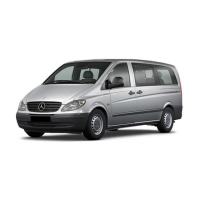Transporting loads with the vehicle
Loading guidelines
G
Risk of injury
Secure and position the load as described in
the loading guidelines. You or others could
otherwise be injured by the load slipping or
being thrown around in the event of sharp
braking, sudden changes in direction or on
poor road surfaces. This also applies to
seats which have been removed if they re-
main in the vehicle.
Even if you follow all loading guidelines, the
load increases the risk of injury in the event
of an accident. Observe the tips in the “Se-
curing a load” section.
G
Risk of accident
Do not allow the load, including passengers,
to exceed the permissible gross vehicle
weight or the permissible axle loads for your
vehicle.
If the permissible axle loads or permissible
gross vehicle weight are exceeded during
transport, tyre durability and road safety are
adversely affected. The vehicle’s handling
and steering characteristics change notice-
ably. Braking and stopping distances are
significantly longer.
The vehicle’s driving, steering and braking
characteristics change as the gross vehicle
weight increases or the centre of gravity be-
comes higher.
Always make sure that the distribution of
the load is correct and adapt your driving
style according to the load.
G
Risk of injury
Following an accident, have a damaged load
compartment floor or damaged loading sur-
face, the lashing eyelets and the lashing ma-
terials checked by a specialist workshop
which has the necessary specialist knowl-
edge and tools to carry out the necessary
work.
Mercedes-Benz recommends that you use a
Mercedes-Benz Service Centre for this pur-
pose. In particular, all work relevant to
safety or on safety-related systems must be
carried out at a qualified specialist work-
shop.
! If you are using a roof rack system, observe
the maximum roof load and maximum roof rack
system load.
You will find information about the maxi-
mum roof load and maximum tailgate load
in the "Technical data" section
(
e page 354). You will find information
about the roof rack systems in the "Carrier
systems" section (
e page 229).
Before loading
E Tyre pressure: check the tyre pres-
sure and correct if necessary
(
e page 352).
E Electronic level control (ENR): lower
vehicle if necessary (
e page 198).
E Load compartment floor: clean the
load compartment floor.
The load compartment floor must be
free from oil and dust, dry and clean
swept to prevent the load from slip-
ping.
E Place non-slip mats (anti-slip mats) on
the load compartment floor if neces-
sary.
! As soon as the non-slip mats show signs of
deformation or develop squashed areas, or
traces of cracking/cutting, they can no longer
be used to secure a load and must be replaced.
Operation
Transporting loads with the vehicle
217
4
Nur fuer internen Gebrauch

